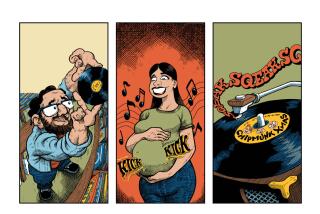All Your Tapes and Records Can Be New .WAV
- Share via
Now that a CD recorder can be acquired for less than the cost of a Motorhead box set, consumers have an affordable way to convert their old LPs and tapes to shiny plastic discs.
The process is straightforward but very time-consuming. That’s because you have to play the record or tape to convert it into a digital file that can, in turn, be burned onto a CD. For $30 to $50, though, you can find software that speeds up the conversions and makes them more sonically rewarding.
The first step is to put a turntable (or tape player) and an amplifier near your PC. Then run a Y-shaped cable from your amplifier’s Tape Out jacks to the Line In port on the back of your computer. That way, signals from the turntable or tape player will run through a pre-amplifier before being fed into your computer’s sound card, providing a critical volume boost.
To avoid distortion, you’ll need to make sure the signal coming into your computer isn’t too loud. That means checking the volume settings in the computer’s Master Volume control, which you can display in a Windows PC by double-clicking on the Volume icon.
To display the slider for recording through the Line In jack, pull down the Options menu in the Master Volume control and select Properties. Under the heading “Adjust Volume for,” select Recording, click on the box next to “Line In” and then click OK.
After the Line In volume slider appears, make sure there’s a check mark in the Select box below the slider. Play a few passages from the songs you want to record that are likely to be loud, and watch the indicator in the window next to the slider. You’ll want to keep the indicator solidly in the green zone.
You’ll need two pieces of software to finish the job: one to record the music from your LPs or tapes in digital form, the other to record them onto a CD. The former can be downloaded from the Web or purchased on a CD-ROM; the latter typically comes bundled with a CD-RW drive.
The options for the recording software include two of the most popular free programs for playing music on a computer--RealJukebox and MusicMatch Jukebox. However, RealJukebox can’t record more than one song at a time, which is impractical when you’re trying to record entire LPs or tapes. And MusicMatch will record multiple songs only if you fiddle with the advanced recorder settings.
A much easier route is to buy a music-editing program designed for converting analog recordings into CDs, most notably the $50 Audio Cleaning Lab from Magix. The Audio Cleaning Lab easily converts entire LPs or tapes into a string of .WAV files that can be shuffled or mixed with songs from other sources. It also offers a variety of software tools to filter out surface noise, adjust song volumes and edit out unwanted segments.
The filters are particularly useful for removing the clicks, pops and hisses from scratched or dusty records. The software also can enhance the sound electronically--boosting selected frequency bands, for example.
Other options include Magix’s MP3 Maker, which sells for $35, and LP Recorder/LP Ripper from CFB Software, which sells for $40.
Whatever software you choose, it’s best to record the songs as uncompressed .WAV files to preserve as much sound quality as possible. The CD burning software that came with your CD-RW drive, such as Roxio’s Easy CD Creator, can then take the .WAV files and record them onto a blank CD.
*
Times staff writer Jon Healey covers the convergence of entertainment and technology.
*
Connect: Check out past columns at www.latimes.com/doit
More to Read
The biggest entertainment stories
Get our big stories about Hollywood, film, television, music, arts, culture and more right in your inbox as soon as they publish.
You may occasionally receive promotional content from the Los Angeles Times.










